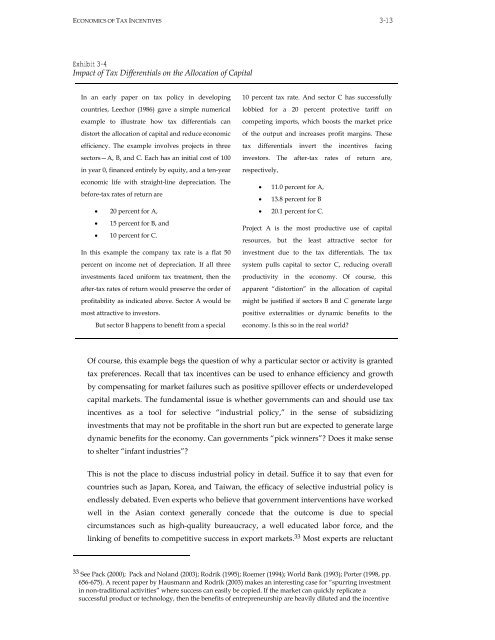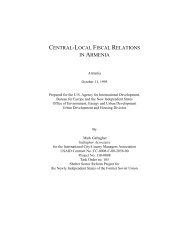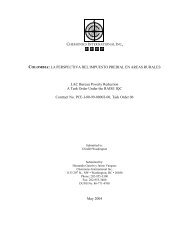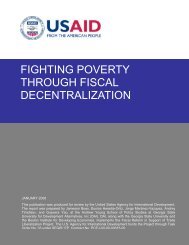Effectiveness and Economic Impact of Tax Incentives in the SADC ...
Effectiveness and Economic Impact of Tax Incentives in the SADC ...
Effectiveness and Economic Impact of Tax Incentives in the SADC ...
You also want an ePaper? Increase the reach of your titles
YUMPU automatically turns print PDFs into web optimized ePapers that Google loves.
ECONOMICS OF TAX INCENTIVES 3-13<br />
Exhibit 3-4<br />
<strong>Impact</strong> <strong>of</strong> <strong>Tax</strong> Differentials on <strong>the</strong> Allocation <strong>of</strong> Capital<br />
In an early paper on tax policy <strong>in</strong> develop<strong>in</strong>g<br />
countries, Leechor (1986) gave a simple numerical<br />
example to illustrate how tax differentials can<br />
distort <strong>the</strong> allocation <strong>of</strong> capital <strong>and</strong> reduce economic<br />
efficiency. The example <strong>in</strong>volves projects <strong>in</strong> three<br />
sectors—A, B, <strong>and</strong> C. Each has an <strong>in</strong>itial cost <strong>of</strong> 100<br />
<strong>in</strong> year 0, f<strong>in</strong>anced entirely by equity, <strong>and</strong> a ten-year<br />
economic life with straight-l<strong>in</strong>e depreciation. The<br />
before-tax rates <strong>of</strong> return are<br />
• 20 percent for A,<br />
• 15 percent for B, <strong>and</strong><br />
• 10 percent for C.<br />
In this example <strong>the</strong> company tax rate is a flat 50<br />
percent on <strong>in</strong>come net <strong>of</strong> depreciation. If all three<br />
<strong>in</strong>vestments faced uniform tax treatment, <strong>the</strong>n <strong>the</strong><br />
after-tax rates <strong>of</strong> return would preserve <strong>the</strong> order <strong>of</strong><br />
pr<strong>of</strong>itability as <strong>in</strong>dicated above. Sector A would be<br />
most attractive to <strong>in</strong>vestors.<br />
But sector B happens to benefit from a special<br />
10 percent tax rate. And sector C has successfully<br />
lobbied for a 20 percent protective tariff on<br />
compet<strong>in</strong>g imports, which boosts <strong>the</strong> market price<br />
<strong>of</strong> <strong>the</strong> output <strong>and</strong> <strong>in</strong>creases pr<strong>of</strong>it marg<strong>in</strong>s. These<br />
tax differentials <strong>in</strong>vert <strong>the</strong> <strong>in</strong>centives fac<strong>in</strong>g<br />
<strong>in</strong>vestors. The after-tax rates <strong>of</strong> return are,<br />
respectively,<br />
• 11.0 percent for A,<br />
• 13.8 percent for B<br />
• 20.1 percent for C.<br />
Project A is <strong>the</strong> most productive use <strong>of</strong> capital<br />
resources, but <strong>the</strong> least attractive sector for<br />
<strong>in</strong>vestment due to <strong>the</strong> tax differentials. The tax<br />
system pulls capital to sector C, reduc<strong>in</strong>g overall<br />
productivity <strong>in</strong> <strong>the</strong> economy. Of course, this<br />
apparent “distortion” <strong>in</strong> <strong>the</strong> allocation <strong>of</strong> capital<br />
might be justified if sectors B <strong>and</strong> C generate large<br />
positive externalities or dynamic benefits to <strong>the</strong><br />
economy. Is this so <strong>in</strong> <strong>the</strong> real world?<br />
Of course, this example begs <strong>the</strong> question <strong>of</strong> why a particular sector or activity is granted<br />
tax preferences. Recall that tax <strong>in</strong>centives can be used to enhance efficiency <strong>and</strong> growth<br />
by compensat<strong>in</strong>g for market failures such as positive spillover effects or underdeveloped<br />
capital markets. The fundamental issue is whe<strong>the</strong>r governments can <strong>and</strong> should use tax<br />
<strong>in</strong>centives as a tool for selective “<strong>in</strong>dustrial policy,” <strong>in</strong> <strong>the</strong> sense <strong>of</strong> subsidiz<strong>in</strong>g<br />
<strong>in</strong>vestments that may not be pr<strong>of</strong>itable <strong>in</strong> <strong>the</strong> short run but are expected to generate large<br />
dynamic benefits for <strong>the</strong> economy. Can governments “pick w<strong>in</strong>ners”? Does it make sense<br />
to shelter “<strong>in</strong>fant <strong>in</strong>dustries”?<br />
This is not <strong>the</strong> place to discuss <strong>in</strong>dustrial policy <strong>in</strong> detail. Suffice it to say that even for<br />
countries such as Japan, Korea, <strong>and</strong> Taiwan, <strong>the</strong> efficacy <strong>of</strong> selective <strong>in</strong>dustrial policy is<br />
endlessly debated. Even experts who believe that government <strong>in</strong>terventions have worked<br />
well <strong>in</strong> <strong>the</strong> Asian context generally concede that <strong>the</strong> outcome is due to special<br />
circumstances such as high-quality bureaucracy, a well educated labor force, <strong>and</strong> <strong>the</strong><br />
l<strong>in</strong>k<strong>in</strong>g <strong>of</strong> benefits to competitive success <strong>in</strong> export markets. 33 Most experts are reluctant<br />
33 See Pack (2000); Pack <strong>and</strong> Nol<strong>and</strong> (2003); Rodrik (1995); Roemer (1994); World Bank (1993); Porter (1998, pp.<br />
656-675). A recent paper by Hausmann <strong>and</strong> Rodrik (2003) makes an <strong>in</strong>terest<strong>in</strong>g case for “spurr<strong>in</strong>g <strong>in</strong>vestment<br />
<strong>in</strong> non-traditional activities” where success can easily be copied. If <strong>the</strong> market can quickly replicate a<br />
successful product or technology, <strong>the</strong>n <strong>the</strong> benefits <strong>of</strong> entrepreneurship are heavily diluted <strong>and</strong> <strong>the</strong> <strong>in</strong>centive











